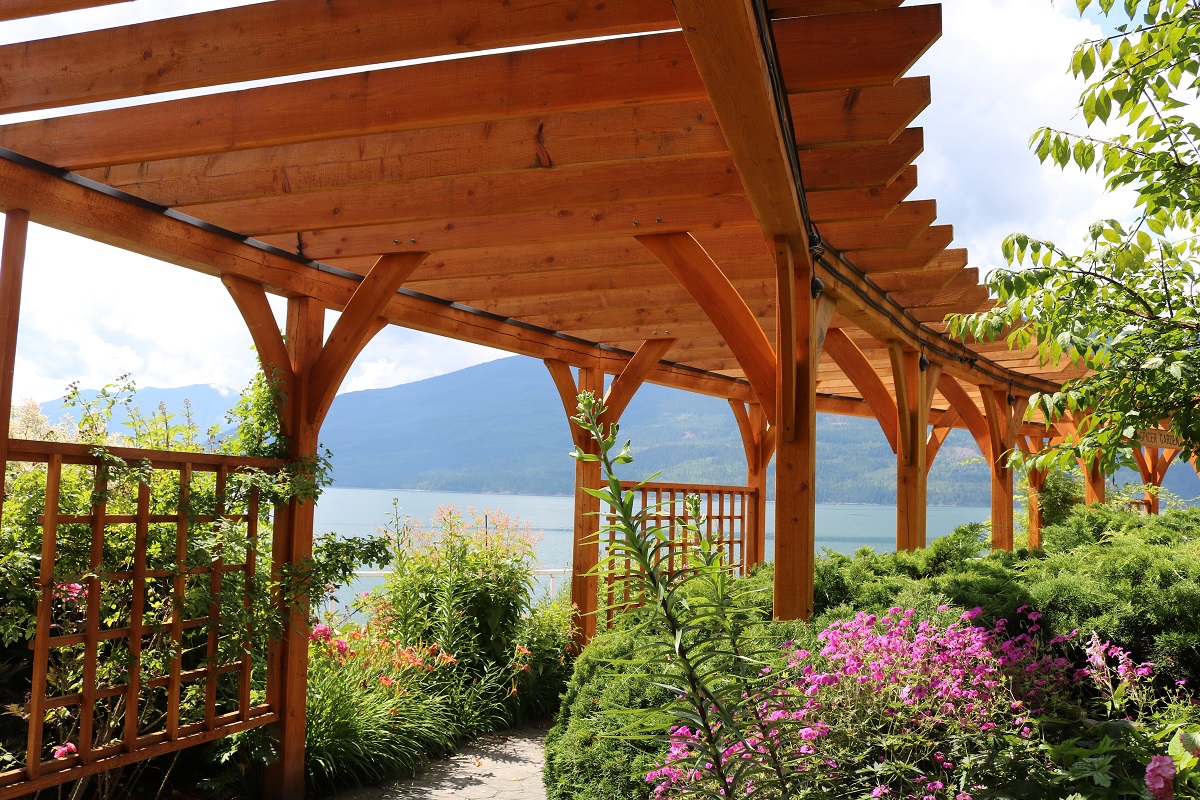
Like most people outside the landscaping profession, you probably don’t have a clear picture in your head when you hear the word “pergola.” Lots of different outdoor structures are mistakenly called pergolas, and pergolas themselves are often mislabeled as gazebos. This guide to pergolas will cut through the confusion and explain the types, uses, costs, and installation options for your landscape.
Let’s explore how you can reach your personal landscaping goals with a pergola.
What is a Pergola?
At the most basic level, a pergola is an outdoor structure comprised of columns or posts supporting an open roof of beams and rafters.
A pergola is NOT a:
- Gazebo, which has a closed roof, usually sits on raised ground, and often has a low wall or railing around its perimeter.
- Arbor, which is much smaller than a pergola and usually used to frame a walkway or gate entrance.
- Trellis, which is a panel of latticework typically mounted to a wall, fence, or other structure.
- Pavilion, which is a roofed structure similar to a gazebo but with open sides.
When you ask your local landscaper or hardware store for help with your pergola project, make sure he or she knows exactly what you’re talking about (and what you aren’t).
Components of a Pergola
While you can find pergolas in several different styles and materials, they all have a few things in common. Before we get into all the bells and whistles, here are the essential parts of any pergola.
- Columns: These are the pillars that support the pergola’s roof and often serve as a framework for outdoor living spaces. The number of pillars depends on the size of the pergola and whether it’s free-standing or attached to a building.
- Beams and rafters: Beams and rafters are the slats that make up the pergola’s open roof. The beams go on top of the columns, then the rafters go on top of the beams.
- Stringers/purlins (optional): Stringers, aka purlins, go on top of the rafters, running perpendicular to them. They add more shade, but not all pergolas have them.
- Ledger board (optional): In attached pergolas, the ledger board replaces the beam on the side attached to the wall. The ledger board is the part that connects the pergola to the building.
Types of Pergolas
Pergolas can enhance your landscape, increase your home’s value, and give you a place to relax and enjoy the great outdoors, but which type is best for you? Pergolas from most manufacturers are highly customizable, so your size and shape options are limitless. These are some of the basic types:
Freestanding Pergola

A freestanding pergola is exactly what it sounds like: A pergola that stands alone as a landscape feature separate from your home. You would use this type of pergola in your garden, beside the pool, or to create an outdoor living space away from the house.
Attached Pergola

With an attached pergola, one side attaches directly to a wall of your home. You would use this style if you want to cover a space connected to your house, such as a patio or deck. An attached pergola can make an outdoor living space feel like an extension of an indoor room instead of a separate feature.
Arched Pergola

Most pergolas have a flat roof, but you can find several designs with arched tops. An arched pergola can look more romantic than a flat one and give your space a more elegant and uncommon appearance.
Louvered Pergola
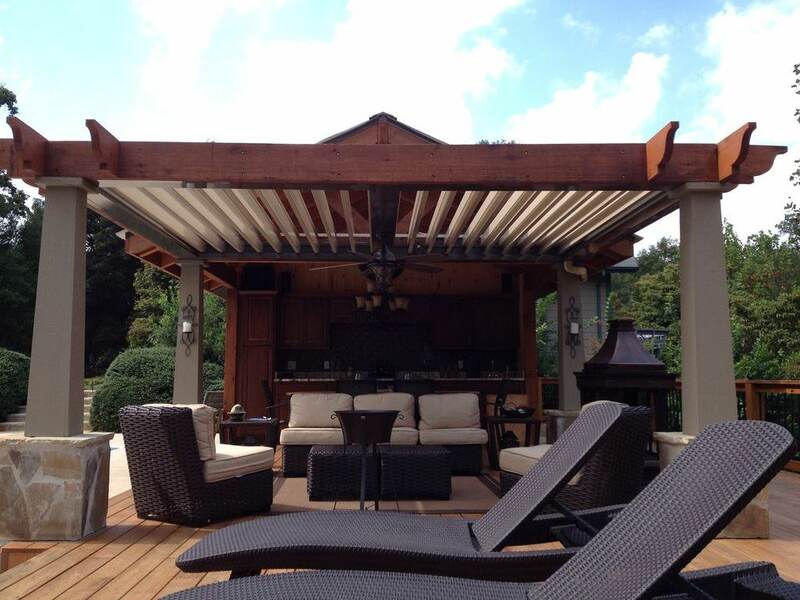
Instead of traditional slats, a louvered pergola has adjustable louvers as rafters. You can open and close the louvers to let in more or less sun as needed. There are automatic and manual models of louvered pergolas.
Awning Pergola

Small, awning style pergolas mount right onto the wall and don’t need support posts or columns. You can install an awning pergola over a door, window, or garage for shade and aesthetics. For more shade, add flowering climbing vines or another type of cover.
Pergola Materials
Pergolas don’t only vary in appearance. They’re also made of different materials. What your pergola is made of determines how long it’s likely to last, how much maintenance it will need over the years, and how much it will cost.
Wood Pergola

Wood is probably the most common (and cheapest) material for pergolas. If you build one from scratch, you will almost definitely use wood. Cedar pergolas are most popular because they offer the most bang for your buck, while redwood is a more premium option.
Though wood is cheaper in the moment, keep in mind that you’ll need to repaint or restain it every few years to prevent pests and rot. Maintenance costs can add up over a long period of time.
Vinyl Pergola
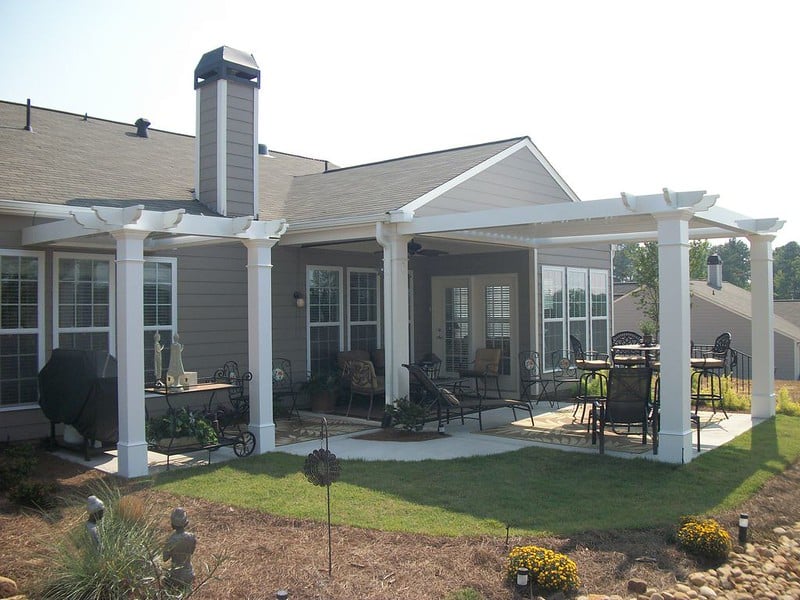
Compared to wood, vinyl pergolas are extremely low-maintenance. They last for many years with nothing more than occasional pressure washing.
Vinyl might be durable and easy to care for, but the downside is high-quality vinyl can get pretty expensive.
Aluminum Pergola

Aluminum is a great choice if you’re looking for a more modern pergola. Most of the time, aluminum pergolas have simple shapes and clean lines that blend well with contemporary architecture and landscaping.
Like vinyl, aluminum doesn’t require much maintenance since it isn’t susceptible to rust.
Steel Pergola

Steel is another material that can give your pergola a modern look, though steel tends to have more of an industrial, heavy-duty appearance than aluminum. That might be because steel literally is much heavier than aluminum, making it more sturdy and durable.
However, steel can rust when it’s regularly exposed to rain and humidity, so you’ll have to take rust protection precautions.
Fiberglass Pergola
Fiberglass is weather-resistant, low-maintenance, and long-lasting. It also holds paint well, so you can paint it any color to match your landscape. Because it won’t corrode or rust, you won’t have to worry about treating or cleaning your pergola regularly.
Fiberglass might be the most convenient option for your pergola, but keep in mind that it also tends to be the most expensive.
Concrete Pergola
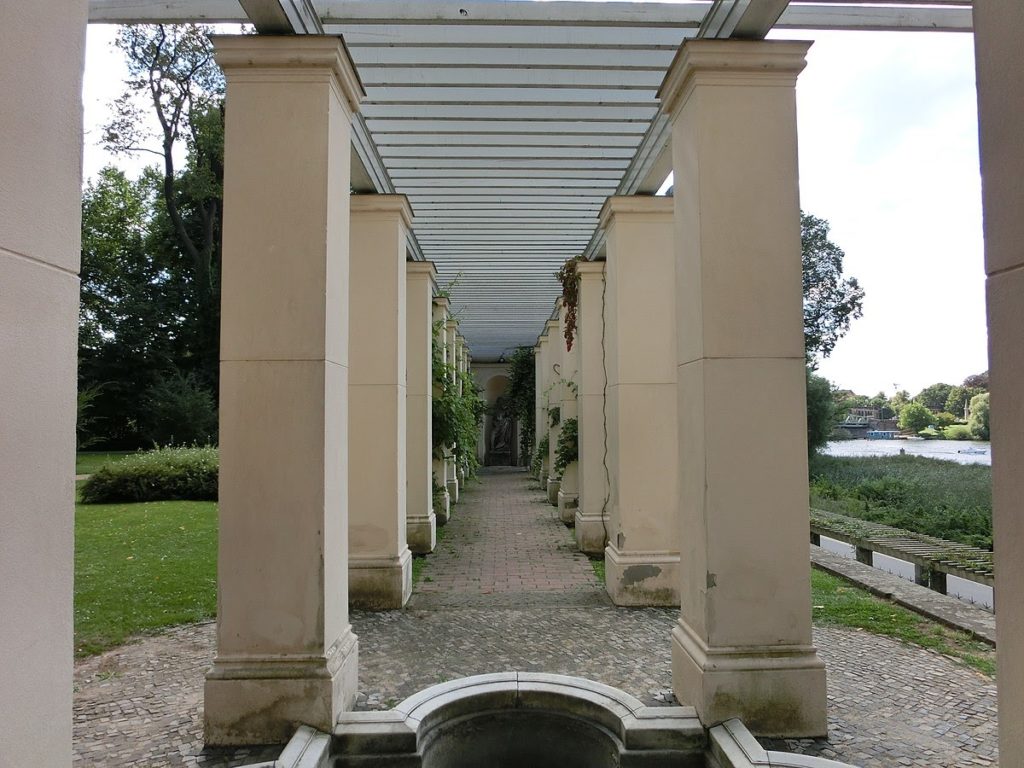
Precast or custom poured concrete pillars can give your pergola a classic look reminiscent of Ancient Greece or Rome. Alternatively, you could create a concrete pergola design with clean, geometric lines for a more trendy look.
Concrete will essentially last forever, and the only maintenance it will require is occasional cleaning and repairing of cracks and chips.
Uses for a Pergola
Now you have a good idea of what a pergola is and what your different options are when shopping for one. But you might still be wondering how you can actually use a pergola in your landscaping.
Here are five basic pergola ideas to help you get started with your own unique design.
1. Create an Outdoor Room

With a pergola, you can turn your ordinary seating area, outdoor kitchen, or barbecue space into a fully realized outdoor room. A pergola can add structure to your outdoor living area without blocking out breezes and sunlight.
What this means: You can combine the benefits of relaxing outdoors with the comforts of being indoors.
Keep in mind, unless you add some sort of shade canopy, a pergola doesn’t provide much protection from the elements. For this reason, choose outdoor furniture that can withstand wind, rain, and sun exposure.
2. Cover a Patio

An attached pergola can make your backyard patio feel like a new room addition instead of just a separate outdoor space. Add complementary patio furniture to tie the space together and create a nook for eating, chatting, or anything else you like to do with family and friends.
If you add a cover, a pergola can also shade your patio and protect it from rain.
A Note on Cost: Patios are one of the least expensive outdoor hardscaping projects to add to your landscape. A professionally installed patio costs $3,994 on average, but the price for a DIY patio is much less at around $1,235.01 – $1,250.05.
3. Upgrade a Swimming Pool or Hot Tub Area

Landscaping around a pool or hot tub can be tricky. You might want privacy, or you might want to make your pool look more inviting. Either way, a pergola could be the low-maintenance solution for you.
Add privacy screens and a pergola cover to keep prying eyes out of your pool area … and leaves and other debris out of your filters.
4. Elevate Your Garden Design

A pergola can add an exciting architectural element to a plain garden without blocking the sunlight and rainwater plants need to survive.
By adding hanging plants and climbing vines to your pergola, you can (literally) elevate your garden. Vertical gardening solutions like these are perfect for ambitious gardeners with limited backyard space.
Good climbers to incorporate with your garden pergola include trumpet honeysuckle, wisteria, and climbing roses.
5. Frame a Walkway

If you already have a walkway winding through your garden or front yard, why not turn it into a whimsical experience by adding a pergola?
Since pergolas come in all shapes and sizes, you could even find one to zhuzh up a path through a small side yard.
Let climbing vines cover the sides and roof of your pathway pergola to create a fun botanical tunnel for guests to venture through.
Pergola Accessories
Pergolas become even more versatile when you add accessories. Even if a pergola on its own isn’t enough to achieve your landscaping vision, you’ll probably find exactly what you need with extra frills like these.
Shade Canopy

Many pergola manufacturers understand that most homeowners who install an outdoor structure probably want to use it as a sunshade at least sometimes. That’s why there are hundreds of different pergola covers on the market.
Depending on your needs, you could choose a fabric cover, shade tarp, retractable canopy, or even a hard transparent cover that lets in sunlight but protects from rain and debris.
Privacy
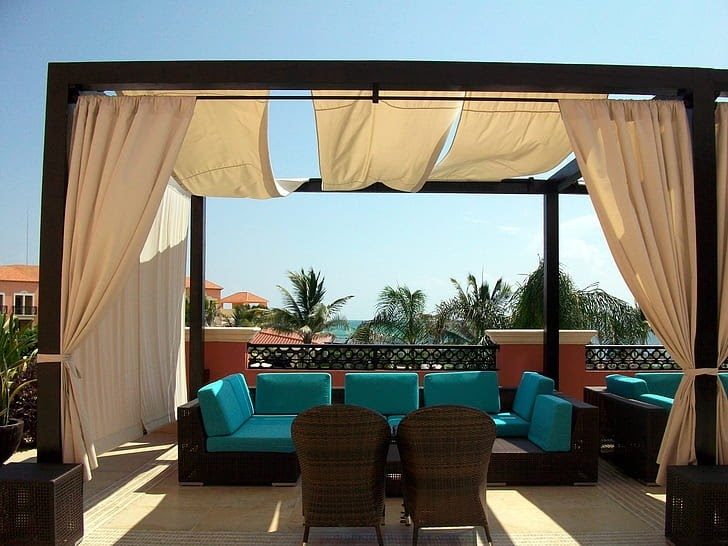
Landscaping for privacy is important for many homeowners. You have lots of options when it comes to making your pergola more private, too. One easy solution is to attach curtains on all sides. You can open or close them depending on whether you’re in the mood for privacy or enjoying the view. Another adjustable option is retractable privacy screens.
For more permanent privacy, you can install living privacy elements around your landscape. Here are a few articles to help you get started:
- 11 Best Privacy Hedges
- How Much Does a Privacy Fence Cost?
- 22 Trellis Ideas that are Simple and Easy
- What is a Living Fence and How Do You Grow One?
- What Are the Best Living Fence Plants for Your Yard?
- 6 Benefits of a Living Fence
Lighting

For dinner parties and other nighttime rendezvous in your outdoor living space, you’ll most likely want to install some kind of outdoor landscape lighting. What kind of lights you use depends on your style and whether or not you hook your pergola up with electricity.
You could hang string lights for a casual, romantic look, paper lanterns for something more exotic, or even a chandelier for elegance.
If you’re a little more adventurous and have room in your budget, you could even install a fire pit or fireplace for lighting (and warming) your outdoor area at night.
Temperature Control

The worst drawback of spending time outdoors is that you have no say in how oppressively hot or freezing cold it gets.
Installing pergola accessories such as ceiling fans or electric heaters can give you a little more control over your outdoor living space’s environment. That way, you can enjoy your pergola even at the height of summer and winter.
Entertainment

Home theaters aren’t only for inside. With a little electrical know-how (or professional help), you can install a TV, speakers, power outlets, and other electronic features in your outdoor living space. Turn watching TV and listening to music into outdoor activities.
Keep in mind that if you’re using outdoor electronics, you’ll most likely want to install a protective pergola cover.
How to Install Your Pergola
Before you install or even purchase your pergola, plan out the space where you want to put it. The most important element of pergola planning is making sure you measure the space accurately.
When measuring how much room you have on the ground, go from column to column. A 10 feet by 10 feet pergola will have columns spaced 10 feet apart.
Also keep in mind that a pergola’s rafters and beams typically hang over the edges, so make sure you have a little extra room up top. You don’t want the extra ends to smash up against any nearby trees or other tall structures.
Once you’ve got your pergola plan all figured out, you have a few options for installation — DIY, pergola kits, or a professional landscaper.
DIY
Of course, you can always build your own pergola from scratch. If you have construction experience and know your way around a power saw, there’s no reason your pergola shouldn’t turn out great.
Pros of a DIY pergola:
- Cheapest option
- Can build it exactly how you want it
Cons of a DIY pergola:
- Requires a lot of work
- No guarantee of how the finished product will look
Prefabricated Pergola Kits
There’s an easier option if you don’t have construction skills or the budget to hire a professional landscaper. When you order a prefabricated pergola kit, all the pieces arrive at your doorstep already cut to the right size. All you have to do is put them together like a giant puzzle.
Assembling a pergola kit is much easier than building one from scratch, but you’ll still need at least one extra set of hands and a full weekend to complete this job.
Pros of a pergola kit:
- Come in many materials and styles
- Easier and faster than building from scratch
Cons of a pergola kit:
- More expensive than DIY
- Still requires substantial work on your part
Hire a Professional Landscaper
You can take the whole burden of installing a pergola off your own shoulders by hiring a professional landscaper to build it for you. Simply select a local landscaping company, and you’ll get the pergola of your dreams without having to break your back or clear your schedule.
Pros of hiring a professional:
- No work for you
- High-quality construction
Cons of hiring a professional:
- Most expensive option
Cost of a Pergola
The most important factor in choosing your pergola, of course, is your budget. Like any other landscaping project, pergolas vary greatly in price depending on size and the material you choose. On average, the cost of pergola installation is about $4,000, but prices range from $2,100 – $6,000.
National average cost of a pergola by size:
- 8 feet x 8 feet: $640 – $3,840
- 10 feet x 10 feet: $2,000 – $6,000
- 12 feet x 12 feet: $2,880 – $8,640
If you have a different size in mind, calculate the cost yourself, knowing that pergolas cost between $20 – $60 per square foot. If you plan to hire a professional landscaper, labor costs make up $500 – $1000 of the final price estimate.
You can shop prefabricated pergolas on Amazon or buy directly from the manufacturer for more customization options. Some top-rated pergola brands include Backyard Discovery, Sunjoy, and Vita (formerly known as New England Arbors).
FAQ About Pergolas
Check your local city and county laws for building permit information. You’ll also want to check your HOA’s guidelines on outdoor structures.
Pavilions and gazebos are similar to pergolas but have a solid roof to block out sun and rain. Due to the additional building materials and roof, gazebos cost slightly more than pergolas, so be prepared for the higher expense.
Your pergola’s rafters should run north and south for maximum shade throughout the day.
Pergola Preparations
Whether you’ve planned to DIY or hire a local lanscape professional, a pergola is a worthwhile addition to your outdoor living space. Pergolas provide extra shelter and seating space that allow you and your guests to enjoy the great outdoors more often throughout the year.
Before you invite guests for dinner under your new pergola, why not have a local lawn care pro come to mow and edge? They’ll take care of the lawn so you can take care of everything else.
Main Photo Credit: Unsplash